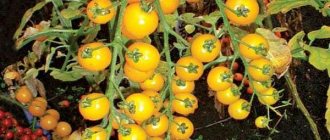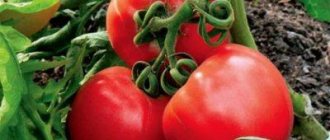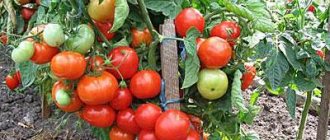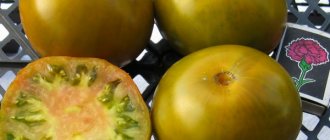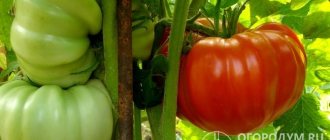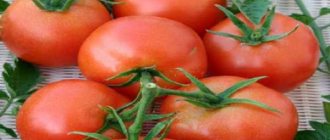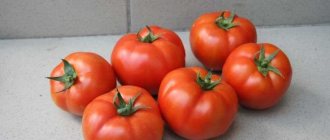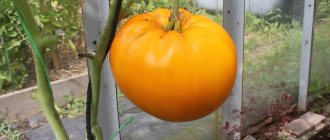Among the good, proven cherry hybrids, Caramel red F1, a delicious tomato with juicy and sugary fruits, is of constant interest.
| Height | Landing location | Ripening time | Fruit color | Fruit size | Origin | Fruit shape |
| Tall | Greenhouse, Open ground | Early ripening | Reds | Small | Hybrid | Round |
An excellent variety that does not require seedling preparation - Alpha tomato: tips for planting and proper care
Tomato Alpha is an early-ripening, resistant variety for open ground. It allows you to get a good harvest of ripe tomatoes and enjoy their great taste after 3 months. This variety can also be grown without seedlings.
| Height | Landing location | Ripening time | Fruit color | Fruit size | Origin | Fruit shape |
| short | Greenhouse, Open ground | Early ripening | Reds | Small | Variety | Flat-round |
Description and characteristics of the variety
The tomato is early ripening, the fruits ripen in 85-90 days. The tomatoes have a flat-round shape, red color and an average weight of 70 g.
The plant is determinate (low-growing), its height reaches 40-50 cm. The leaves are potato-type, the inflorescences are simple. The bush is resistant to diseases and does not require pinching, but some gardeners remove the few stalks from the bottom of the stem.
Country of origin and year of registration
The variety was bred in Russia by a well-known agro. Included in the State Register in 2004 as a tomato intended for planting in open ground in garden plots, household plots and small farms.
Growing regions
Tomato is successfully grown in all regions of Russia, except the far north. Planting the variety in the southern regions produces ripe fruits in June, and in the northern regions in July.
Advantages and disadvantages
- disease resistance;
- the ability to grow without seedlings;
- ease of care;
- tolerance to unfavorable conditions;
- good taste.
Minuses:
- not intended for long-term storage and transportation;
- not the highest yield due to the compactness of the bush.
Productivity
Compliance with correct agricultural technology allows the yield of the variety, despite the diminutiveness of the plants, to reach 6.3 kg/sq.m. Harvest for a long time before the onset of frost.
Features of cultivation and storage
When caring for and growing tomatoes, it is important to consider the following features:
- containers with seedlings are covered with film and kept in a room with a temperature of at least 20 degrees;
- in the 2nd week of the seedlings’ life, it is advisable to harden them;
- The variety does not require regular pinching, but it is necessary to remove side shoots to form the main stem.
Hardening allows the tomatoes to store high levels of sugar and form a large layer of epidermis. As a result, the plants will be reliably protected from wind and sudden temperature changes.
Planting and care
Despite the fact that the Alpha tomato can be grown without seedlings, it is better not to use it. The seedling method guarantees the highest germination of seeds.
To prevent diseases, before planting, it is advisable to treat the seeds with a manganese solution and dry them. After processing, they are sown in moist soil in peat or plastic containers.
At 40-45 days, the seedlings are transplanted into open ground. The choice of planting site is in favor of fertile soils due to the fact that this variety is actively growing. Since tomato bushes are compact, they are planted 6-7 pieces per square meter and a wooden stake is placed next to each one.
Tomato care involves regular watering with warm water when the soil dries out. In between, weeding and loosening are carried out. Several times a season, plants are fed with mineral and organic fertilizers.
Features of cultivation
When caring for and growing tomatoes, it is important to consider the following features:
- containers with seedlings are covered with film and kept in a room with a temperature of at least 20 degrees;
- For 2 weeks of the seedlings’ life, it is advisable to harden them;
- The variety does not require regular pinching, but it is necessary to remove side shoots to form the main stem.
Features of the plant
Both varieties belong to the same type of cherry tomatoes, and do not differ in anything except color. The varieties are hybrid, so the vegetable grower will not be able to leave the tomatoes he likes for seeds. Planting material will have to be purchased annually in the store.
Bushes of indeterminate type, tall. In greenhouse conditions, the plant can reach a height of more than 2 m. Tomatoes can also be grown in open ground throughout central Russia and in the southern regions. In the conditions of the Moscow region, the south of the Urals and Siberia, it is recommended to pinch the bushes around mid-August so that the ovaries on the upper cluster have time to grow before the onset of cold nights or early frosts.
The Caramel tomato variety (both yellow and red varieties) is resistant to temperature changes and tolerates cold weather and prolonged rains well.
The characteristics and description of the variety given by Russian vegetable growers note that the number of berries does not decrease even in unfavorable years. But those who have been growing the variety for several years recommend choosing a sunny and well-warmed area for it. Small-fruited varieties Red and Yellow caramel will be sweet like candy only in such conditions.
Caramel tomato is an early ripening variety. It takes about 120 days from sowing the seeds to harvesting the first ripe tomatoes. During the season, 4-5 clusters with many fruits are formed on the plant. The average weight of 1 berry does not exceed 30 g, but up to 50 pieces can be formed on a brush. identical ovaries that grow together and ripen almost simultaneously.
The average yield of 1 bush is 4-4.5 kg of marketable products per season. To increase the yield from a plant, they practice growing a bush with 2-3 stems. Tall tomatoes require tying to a trellis and removing excess growth throughout the season.
Tomato Amber honey characteristics and description of the variety yield with photo
The variety was bred by Siberian breeders. Ultra early ripening, determinate, standard. Suitable for growing in greenhouses, indoors or open ground.
Amber tomatoes are great for pickling, fresh salads, stuffing, freezing or drying, as well as for tomato juice. Well preserved and transported.
Description of the tomato variety Yantarny
The variety is characterized by the following features:
- Cold resistant. Withstands light frosts (up to -1), although some leaves may freeze. Fruits set, even if flowering occurs during cold weather.
- The productivity of the variety is high. From one sq. meter you can get about 5 kg.
- The fruits ripen within 80-100 days, so the variety is ultra-early ripening.
- Abundant flowering. Brushes are formed above the 5-6th leaf, and then through the leaf or two in a row. The flowers are self-pollinating and cold-resistant.
- Determinate, standard bush, stops growing on its own, without pruning the top.
- The branching is active and abundant, forms a wide, low bush up to 60 cm in height.
- The stalk is juicy and thick. The leaves are medium sized, bright green.
- The tomato is yellow, often amber in color, with thin skin. Diameter - 5-6 cm, spherical shape, weight about 70 g. The fruit is juicy and sweet.
- The variety is resistant to macrosporiosis and late blight, and also easily tolerates adverse weather conditions.
Note! There is a variety with a similar name - Yantar tomato, the characteristics and description of the variety are different from Yantarny, do not confuse them. Early (period from germination to ripening 80-100 days), low-growing, determinant, productive, unpretentious tomato variety of amateur selection for open ground and film shelters
Suitable for growing in containers
Early (period from germination to ripening 80-100 days), low-growing, determinant, productive, unpretentious tomato variety of amateur selection for open ground and film shelters. Suitable for growing in containers.
If you grew Yantarny tomatoes (not to be confused with Yantarny 530 from Sedek), please write how you liked them. What was the yield and taste of the fruit? Will you grow this tomato again? Briefly describe the advantages and disadvantages of this tomato in your opinion. If possible, attach to the comment a photo of the entire bush as a whole or individual fruits that you grew. Thank you!
Your reviews of the Yantarny tomato, as well as additions to the description, will help many gardeners evaluate this variety more objectively and decide whether it is worth planting or not.
Advantages and disadvantages
The advantages of this variety include versatility, short stature, productivity, and ease of care. Compared to indeterminate varieties, the bushes are more compact and bloom profusely.
Note! These tomatoes are distinguished by their bright color and excellent taste. Disadvantages - relatively short fruiting period
Determinate varieties bear fruit until frost, and Yantarny - only once a season for 3-4 weeks. The fruit size is small, which for some is also a disadvantage
Disadvantages: relatively short fruiting period. Determinate varieties bear fruit until frost, and Yantarny - only once a season for 3-4 weeks. The fruit size is small, which is also a disadvantage for some.
The Yantarny variety is perfect even for inexperienced gardeners. Its advantages completely outweigh its disadvantages.
Characteristics and description of the variety
Tomatoes “In Memory of Korneev” are grown in different regions of Russia. Success is achieved both on soil in the open air, and in greenhouse conditions, and under film coverings. Tomatoes belong to tall, indeterminate, mid-season varieties.
The bushes can grow to a maximum of 1.5 meters. Their stems are powerful and strong, and can consist of one or a pair of trunks. The bushes are also spreading and have a large number of brushes, which are located along the entire perimeter of the plants. The foliage is not too large in size, and its color matches that of most tomato plants - regular green.
Tomato fruits have a round shape, sometimes flat-round. Their color is bright pink. The taste is sugary, with delicate aromatic pulp. The weight of one tomato can reach up to 500 grams. There are few seeds inside.
Advantages and disadvantages of the variety
Tomatoes “In Memory of Korneev” have smooth, even skin, thanks to which their appearance is ideal. In addition, the variety has a whole list of advantages:
- The harvest is mid-ripening, as the fruits ripen in about 120 days.
- Huge size tomatoes with a unique pink-raspberry hue.
- A high-yielding variety, you can harvest about 6 kilograms of vegetables from one bush.
- Up to 4 fruits with a strong skin and a small number of seeds inside can form on the brush.
- Resistant to pests and many diseases.
- Excellent long-term storage and transportability, as the tomatoes do not crack.
One of the features is that it is necessary to properly transport tomatoes over long distances (place them in boxes in one layer, without touching each other). Thus, breeders recommend transporting tomatoes only if they were picked during the period of technical maturity. And already during transportation, the fruits will ripen on their own.
But among the disadvantages are the whimsical nature of care; the variety must be constantly fed.
Sowing seed material
Seeds are sown in late March - early April, approximately 45-60 days before planting in the greenhouse. You should not sow early, so as not to overexpose the seedlings in the pot later - this will negatively affect the yield.
IMPORTANT: When working with seeds, hygiene rules must be observed. Wash your hands thoroughly, disinfect equipment and containers, steam the soil before filling to 60*C. Expanded clay is poured onto the bottom of the planting container, then the main soil. A mixture of peat, turf and sand, well fertilized with humus, is used as soil.
The seeds are laid out in grooves 1.5 cm deep with an interval of 2 cm, leveled, watered with warm water and covered with polyethylene to create a greenhouse effect.
Expanded clay is poured onto the bottom of the planting container, then the main soil. A mixture of peat, turf and sand, well fertilized with humus, is used as soil. The seeds are laid out in grooves 1.5 cm deep with an interval of 2 cm, leveled, watered with warm water and covered with polyethylene to create a greenhouse effect.
The following temperature regime for seedlings is recommended:
- 28-30*C – under film until shoots emerge;
- 22-24*C – for the main growing season after removing the film;
- 15*C in the afternoon, 12*C – during hardening two weeks before planting.
After the formation of the second true leaf (10-14 days after sowing), the plants are planted in a separate container. It is best to plant them in paper or peat cups - this will allow you to replant the bushes without removing them from the pot.
Rules for planting seedlings
Seedlings are planted in a permanent place when the soil temperature in the greenhouse is at least 10*C and the average daily air temperature is at least 12*C. Planting is carried out using the square-cluster method in planting holes 15 cm deep. A handful of peat, a handful of humus and a pinch of ash are thrown under each bush.
The most important thing when replanting is not to damage the roots of the plants.
Recommended planting pattern:
- The interval between plants is 60 cm;
- Row spacing – 70 cm;
- The maximum planting density is 3 plants per 1 sq.m.
Tomato Caramel yellow
Hybrid variety bred in Russia
- Fact:
The variety is suitable for both private and industrial cultivation. - Fact 2:
The main feature of the variety is the color of the fruit. Ripe tomatoes acquire a beautiful bright yellow hue. - Fact 3:
The variety requires pinching - removal of side shoots. This procedure is best done before lunch, when it is warm and sunny outside. - Fact 4:
The best site for growing tomatoes is the place where legumes, cabbage, onions, carrots or parsley grew last year.
This is also interesting!
“Yellow Caramel” F1 is a hybrid variety bred in Russia. It is suitable for cultivation throughout our country. Produces a plentiful and tasty harvest. It has a sweet taste and universal use.
a brief description of
- Where to grow: glass and film greenhouses.
- Bush height: 170–200 cm.
- Ripening time: 98–105 days.
- Productivity: 4 kg per 1 m2.
- Fruit weight: 30–40 g.
- Application: salads, vegetable dishes, pickling and canning.
- Advantages: early ripening, long fruiting period, harvesting with brushes, excellent taste, decorative effect.
- Disadvantages: tying and shaping the bush, strict adherence to the feeding regime.
Description
"Caramel yellow" is an indeterminate plant that requires pinching off the top to limit growth. If this is not done, it will spend all its energy on developing green mass rather than fruits. It is recommended to form the trunk into 2 stems. This increases productivity.
Tomatoes ripen with long clusters. 25–30, and sometimes 50, pieces on each. The first ovary forms above leaves 9–12. The next ones are formed through 3 sheets. Under favorable conditions - warmth, light, fertilizing - indeterminate varieties can bear fruit for a long time. Giving away up to 50 harvest brushes.
“Yellow caramel” can be grown throughout the Russian Federation under film or in a greenhouse. The variety is suitable for both private and industrial cultivation. Tomatoes are universal in use. They have good product characteristics. Early ripening protects the plant from late blight infection.
Harvest
The main feature of the variety is the color of the fruit. Ripe tomatoes acquire a beautiful bright yellow hue. They are covered with a smooth glossy skin. They look very beautiful and delight with a sweet taste. Tomatoes are often used as a filling agent in multi-colored assorted dishes. The skin does not burst when salted and preserved. The dry matter content is low. Therefore, “Yellow Caramel” produces thick and tasty juice.
Growing
Cultivation begins in March and is carried out according to the standard scheme. First, the seeds are soaked in a growth stimulant or aloe juice. Then they are sown in a container with soil to a depth of 1.5–2 cm. In the phase of several true leaves, a pick is carried out and the first fertilizing is done with mineral fertilizer.
Plants are transplanted into the greenhouse in the second half of May. The soil is first dug up, cleared of weeds and fertilized. Dig holes 12-15 cm deep in the garden bed. Water them well with warm water. Fertilizers are applied. The optimal planting scheme is no more than 3 plants per 1 m2.
Care comes down to watering, loosening, weeding. The bushes are fed with complex fertilizers 3-4 times until the fruit appears. Organic during ripening. After the appearance of the third flower cluster, the formation of a trunk into two stems begins. The variety requires pinching - removal of side shoots. It is better to carry out this procedure before lunch, when it is warm and sunny outside.
Soil preparation
Soil preparation begins in the fall. The soil is dug up well and all weeds are removed. Apply fertilizer consisting of:
loamy soil with manure;
10 kg of wood ash;
The number of mixture components is calculated for 1 m3 of soil.
When transplanting seedlings to a summer cottage, pour 1 tbsp per 1 m2. a spoonful of superphosphate and potassium-based fertilizers. The soil is carefully dug up. 20–30 g of superphosphate, 15 g of potassium, 20 g of nitrogen-containing complexes are poured into the wells.
The best site for growing tomatoes is the place where legumes, cabbage, onions, carrots or parsley grew last year. These plants are not susceptible to diseases typical of nightshades. This means that the likelihood of “Yellow Caramel” dying from viruses and fungi is minimized.
How to grow tomatoes
Caramel is planted in mid-May. Gardeners from the southern regions boldly place the variety in open ground, and gardeners from central Russia are recommended to plant the tomato in a greenhouse or hothouse.
Landing
The land for planting is prepared in the fall. It is dug up, cleaned of weeds and previous plants. The best predecessors of Caramel are bell peppers, carrots, and zucchini. Avoid planting potatoes in beds. In the spring they are dug up again and all the garbage is burned. It would be a good idea to water the soil with a solution of potassium permanganate - this will destroy larvae and dangerous microorganisms.
Bushes are planted at a distance of 40-50 cm from each other. After planting, the beds are watered with warm water. Make sure that it does not get on the leaves and stem, otherwise there is a high risk of developing fungi and viruses. When planting, do not allow the sprouts to break and be careful.
First of all, follow the watering schedule. Do not allow the soil to become waterlogged, otherwise the tomatoes may crack or, even worse, get sick. It is better to water them in the evening or in the morning. For prevention purposes, you can add milk or whey to the water. The solution will not only moisturize, but will also have a preventive effect against diseases and parasitic insects.
The beds need regular loosening. This gives the bushes more oxygen. Also, do not allow the garden to become overgrown with weeds. Weeds take nutrients from tomatoes.
Due to their high growth, the bushes need shaping. Tie them to wooden stakes - they also need to be disinfected with potassium permanganate first. Twine works great for garters. Remember that Caramel forms stepsons that should be removed every 7-10 days.
Important! Do not forget about mineral fertilizers and organic fertilizers. Liquid mullein, wood ash, urea, ammonium nitrate, and superphosphate do an excellent job of this role. For best plant nutrition, alternate between organics and minerals.
Features of cultivation and possible difficulties
Most of all, tomatoes need nitrogen, potassium and phosphorus. The lack of the latter reduces the degree of nitrogen absorption, which leads to a delay in the tying of clusters and cessation of growth. The effect is called “mineral starvation”, which is why the leaves acquire a gray-green color. To prevent this from happening, superphosphate is added at an early stage of development.
Remember that too much nitrogen is harmful. Beneficial substances go into the leaves, an increase in green mass appears, which is why the tomatoes lack nutrition. In addition, due to an excess of nitrogen, nitrates accumulate in tomatoes.
Diseases and pests
Although the hybrid is resistant to many diseases, it is also susceptible to diseases and pests.
Most often you can find the Colorado potato beetle in the garden. This is especially true if the beds with potatoes and tomatoes are nearby. The beetle is capable of destroying not only leaves and stems, but also the fruits themselves. To prevent its appearance, treat Caramel with a solution of Bordeaux mixture. Dry concentrate or solution is sold in stores.
In addition to the beetle, wireworms can damage tomatoes. The insect penetrates the soil and eats the root system, as a result of which nutrients are not supplied to the plant. We recommend fighting the parasite using the drugs “Prestige” or “Bazudin”.
The most common disease is late blight fungus or tobacco mosaic virus. Late blight appears in the form of brown spots, in a mosaic in the form of yellow patterns on the leaves. The causes of diseases are high humidity and heat. For prevention, use “Fitosporin” or a solution based on wood ash.
Description of the Alpha tomato variety and its characteristics
Every gardener strives to get a good harvest and harvest it as early as possible. Tomato Alpha belongs to the early varieties and allows you to get the first berries three months after planting. The originator of the tomato was a large seed selection plant.
General information about the variety
Tomato bears fruit in open ground and greenhouse conditions. In 2004 it was included in the state register. Description of the appearance and characteristics of the variety:
- early, maximum period before fruit ripening is 95 days;
- superdeterminant;
- standard;
- low-growing, bush height does not exceed 50 cm;
- medium foliage;
- potato type leaf;
- simple inflorescence;
- stalk with articulation;
- fruits are set above 5-6 leaves;
- high yield, up to 6.5 kilograms of berries per 1 sq. meters of planting for the summer season;
- unpretentiousness;
- resistance to most diseases of the nightshade family.
The variety is successfully cultivated in all regions of Russia. The exception is the region of the far north. Features and external data of the fetus:
- flat-round shape;
- color when ripe is bright red;
- minimum number of nests 4 pieces;
- weight does not exceed 80 grams;
- juicy;
- sweet taste;
- fragrant;
- smooth;
- moderate density;
- the maximum number of cameras is 6 pieces.
IMPORTANT! Tomatoes are not intended for long-term storage or transportation over long distances
Consumer reviews indicate the versatility of the fruit. The berry is suitable for fresh consumption and is one of the preferred ingredients in vegetable salads.
Recommendations for cultivation
The variety prefers the seedling method of planting. Preparatory work includes:
- preparing containers for seedlings with complex soil for tomatoes;
- sowing seeds to a depth of 1-2 cm;
- covering the planting with film until germination;
- maintaining the room temperature at least 21 degrees;
- after sprouts appear, it is necessary to provide a constant source of light;
- regular watering.
Before planting, seedlings should be hardened off. For 1 sq. It is recommended to place no more than 9 plants per meter of land, according to a 50 x 40 cm pattern. The variety is unpretentious in care and does not require tying or pinching. To get the best harvest you need:
- carry out timely watering with warm water;
- feed the bushes with mineral fertilizers at least 4 times during the summer season;
- loosen and weed the soil.
Gardeners' opinions
This summer I planted new Alpha tomatoes. The early-ripening tomato produced a good harvest 90 days after planting. There were no difficulties with growing. I watered it in the evening, fed it 5 times over the summer, and loosened the soil. I planted 5 bushes per 1 square. meter. Next year I will try to plant more, 8 bushes per 1 square meter. meter. The tomato is compact and does not require garter. I didn’t find any cons for myself.
Valentin Travanov, 54 years old.
Neighbors at their summer cottage discovered the Alpha tomato for me. I sat him down for the first time this year and was pleased. The characteristics and description of the Alpha tomato variety correspond to everything declared by the company’s breeder.
It is unpretentious, resistant to many diseases, and early ripening. The fruits are small, weighing about 50 grams. The taste is good, suitable for vegetable salads. I tried canning and making tomato paste. I recommend!
Agricultural technology
Site requirements
The Yellow Caramel tomato is an unpretentious variety. But, like any other type of tomato, it has its own soil requirements. The plant will grow well in loose, breathable soil. The ideal soil for growing tomatoes is sandy loam or loamy soil. The acidity level should be low or neutral.
The area should be level, well heated and lit. With a lack of light, the sprouts begin to elongate, become thin, begin to bloom late, and bear fruit poorly.
The area needs to be warmed up
It is recommended to plant seedlings in a place protected from drafts and wind. Optimal air humidity is up to 60% maximum. With high humidity there is a risk of developing fungal diseases.
Favorable predecessors are considered:
- Pumpkin;
- White cabbage;
- Beans;
- Onion.
It is recommended to prepare the soil in the fall. The ground needs to be dug up, cleared of weeds and roots from its predecessors. Mineral or organic fertilizers are applied to the ground, then the soil is well loosened.
Even inexperienced farmers can grow Caramel yellow tomatoes. Tomatoes are usually planted in open ground as ready-made seedlings, which are germinated in advance at home.
Growing rules
- Preparing seedlings. The seeds must be placed in a growth stimulator so that they sprout faster. Additionally, they can be disinfected by placing them in a solution with potassium permanganate. They begin to sow seeds from the end of March;
- Seed material is planted in a container or pots, slightly deepening them into nutritious soil (garden soil + humus + vermiculite). Afterwards, the seeds are lightly sprinkled with soil and watered drip-wise so as not to wash out the planting material. The containers are covered with film. Optimum temperature – +23 degrees;
- After mass emergence of seedlings, the container can be moved to a well-lit place. When 2-3 true leaves appear, the seedlings need to be picked;
- Seedlings can be planted in a greenhouse or open ground from mid-May. If spring frosts are possible, it is better to postpone planting;
- Make small holes in the garden bed, sprinkle them with wood ash, add complex mineral fertilizer, and then water the hole;
- The distance between tomatoes should be at least 30 cm, between rows - 50 cm.
Tomato care
In order to reap a rich harvest of tasty and healthy tomatoes by the end of the season, you need to take care of the plant. Simple care manipulations will help you grow a yellow caramel tomato:
- Watering. The soil must be moistened and a crust must not be allowed to form on the bed. It is necessary to water with warm, settled water in the morning or evening, at the root of the bush. It is not advisable to water tomatoes using the drip method, as the blooming flowers can be damaged;
- Loosening. Clearing the bed of weeds and loosening it with garden tools promotes better air permeability of the soil, and the plant develops well. To ensure air flow to the roots, the optimal period of time between loosening is 2 weeks. The first time the soil is loosened to a depth of 12 cm, subsequent times - by 5 cm;
- Garter and stepson. The bushes grow tall, with a large number of tomatoes, so they need additional support. Trellis can be installed immediately when transplanting seedlings into open ground; bushes can be tied up as they grow. The growth of the bush will help stop pinching the top point;
- Feeding. The plant is fed 2 times using organic and mineral fertilizers. From organic matter, you can add bird droppings or mullein. It is advisable to alternate mineral complexes and organic matter.
Diseases and pests
During the growing process, gardeners encounter plant diseases. Insects, soil diseases, and climatic factors can trigger the appearance of the disease. Knowing ways to protect tomatoes from insects and diseases, you can easily preserve the harvest and prevent the development of diseases.
The hybrid is resistant to many diseases:
- Fusarium;
- Tobacco mosaic;
- Verticillium;
- Late blight.
To prevent the occurrence of crown or root rot, it is recommended to regularly loosen the area and mulch the soil.
Loosening the soil
Weeding the beds will protect the plant from viral diseases.
A weekly inspection of the bushes will help you escape attacks from insects and pests. For prevention purposes, bushes can be sprayed with a weak solution of manganese.
When tomatoes are damaged by spider mites or thrips, the bushes are treated with insecticides. Chemicals can be used before the flowering period begins; after the formation of the ovary, it is better to use folk remedies: celandine decoction or onion peel. Affected areas can be trimmed with garden shears and burned to prevent further spread of the insects.
The nuances of growing in open ground and in a greenhouse
In open ground, Caramel tomatoes are planted in a sunny place where cold winds do not penetrate. Under no circumstances should you plant vegetables in low, damp areas where groundwater is close. All this creates unfavorable conditions for the root system.
In a greenhouse, it is important to maintain temperature and humidity levels. Ventilate the room daily, especially if the summer is hot and dry.
For ventilation, experienced farmers advise making special windows. Also, avoid over-watering the room. If there has been a lot of rain, reduce the number of waterings. Inspect the plant regularly for signs of disease.
Farmer reviews
Online opinions of farmers about Caramel are not always clear.
Elena, Tatarstan: “I really love cherry tomatoes and small tomatoes. In my opinion, this is better than large and awkward vegetables. I planted the Caramel variety last year for the first time and I liked it. There is no hassle in care, and the tomatoes taste like honey.”
Evgeniya, Voronezh region: “Yellow Caramel is an excellent hybrid for growing in open ground. I water and fertilize with grass and manure three times a season. I collect them for a long time, I use them mainly in canned form.”
Maria, Moscow region: “The tassels tied quickly, there were few stepsons. But a month later the plant got sick with black leg - I had to destroy 3 bushes. I followed all the rules and took preventive measures, I don’t know why the disease developed. I haven’t decided yet whether to plant it or not.”
